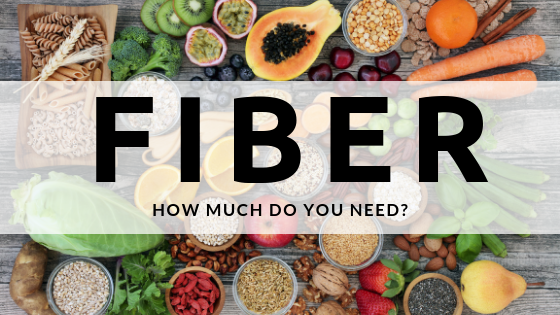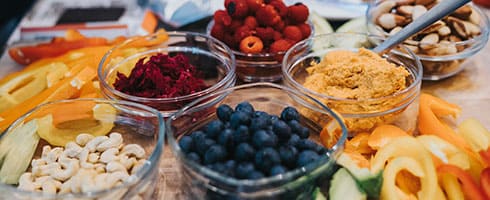
Why Fiber and How Much Do You Need?
Bottom line: Fiber benefits your body in a number of ways. 1) Supports Digestion and Nutrient Absorption: It feeds the good bacteria in your gut, supporting a healthy digestive system. 2) Balances Blood Sugar: It slows the rate that sugar is absorbed into the bloodstream, balancing blood sugar levels. 3) Supports Detoxification: When you get adequate fiber, and hydration, your elimination systems (pooping regularly) is supported. This helps remove waste and toxins from your body. 4) Reduces risk for disease: Adequate fiber intake has been shown to reduce the risk of developing various conditions like heart disease, diabetes, diverticular disease and constipation.
Is your diet short on fruits, vegetables, and whole grains? You may not be getting the fiber you need.
How do you know if you are getting enough?
If you suffer from any of the following issues, inadequate fiber intake might be the cause. Keep in mind that increasing your fiber should be combined with adequate water intake as well as daily movement to make sure you keep everything moving through your body as it should! You should be moving your body a minimum 30 minutes a day, all movement counts.
- You don’t eliminate regularly and suffer from constipation: If you’re having fewer than three bowel movements a week, and the stools are hard and dry, you may be constipated. Boosting your fiber intake can help form soft, bulky stools, relieving and preventing constipation. Be sure to add fiber slowly, so your body gets used to it. And help yourself stay regular by drinking plenty of fluids and exercising regularly. If you can’t get the situation under control, talk to your doctor.
- You are having a hard time maintaining a healthy weight: Eating enough fiber at each meal slows down transit time of your food, keeping you feeling fuller longer after a meal. If you get hungry soon after a meal, try adding more fiber.
- Your blood sugar fluctuates a lot: If you have diabetes and find controlling your blood sugar difficult, talk to your doctor: you may not be getting enough fiber.
- Diet-related nausea & tiredness (Are you doing Keto right?): Getting most of your calories from a high-protein/low-carbohydrate diet — one rich in meat, eggs, and cheese and low in produce — may lead not only to a rise in cholesterol, but also leave you nauseous, tired, and weak.
The Basics
There are essentially two kinds fiber:
- Soluble fiber: Dissolves in water and turns into gel during digestion. It helps slow digestion. It can be metabolized by the “good” bacteria in the gut. It can be found in oat bran, barley, nuts, seeds, beans, lentils, peas, and some fruits and vegetables. It is also found in psyllium, a common fiber supplement.
- Insoluble fiber: Does not dissolve in water. It adds bulk to the stool and helps food pass more quickly through the stomach and intestines. It can be found in foods such as wheat bran, vegetables, and whole grains.
Everyone’s unique fiber needs differ, but the American Heart Association recommends 25-30g/day for adults. If you are looking to increase your fiber intake you will want to slowly to allow your body to adapt and make sure to pay attention to any changes in your digestion and elimination. As usual, make sure you are drinking enough water – aim for half of your weight in ounces a day. If you experience gas or bloating you may need to work on correcting a digestive issue or you may just be more sensitive to the effects of fiber. Everyone is unique!
ADA (The American DIETETICS Association) recommendation:
Children 1 to 3 years, 19 grams a day
Children 4 to 6 years, 25 grams a day
Boys 9 to 13 years, 31 grams a day
Girls 9 to 13 years, 26 grams a day
Adults 25 to 30 grams a day
Remember these are just guidelines and individual needs may vary.
If you are looking to add more fiber to your diet, check out some of these high fiber super stars!
Mentioned a few times now, but not to overlook…adding too much fiber too fast can cause cramps, gas, bloating, and diarrhea. Prevent issues by increasing your daily intake a few grams at a time. And don’t forget to drink tons of water in between your meals!
High Fiber Fruits
| Raspberries | 1 cup | 8.0 g |
| Blackberries | 1 cup | 7.6 g |
| Pear | 1 medium | 5.5 g |
| Mango | 1 medium | 5.4 g |
| Apple with Skin | 1 medium | 4.5 g |
| Strawberries | 1 cup | 3.0 g |
High Fiber Vegetables
| Artichoke | 1 cup | 10.3 g |
| Green peas, boiled | 1 medium | 9.0 g |
| Broccoli, boiled | 1 cup chopped | 5.0 g |
| Brussels sprouts, boiled | 1 cup | 4.0 g |
| Potato, with skin, baked | 1 medium | 4.0 g |
| Sweet corn, boiled | 1 cup | 3.5 g |
| Cauliflower, raw | 1 cup chopped | 2.0 g |
| Carrot, raw | 1 medium | 1.5 g |
High Fiber Grains
| Lentils | 1 cup | 15.6 g |
| Barley, pearled, cooked | 1 cup | 6.0 g |
| Bran flakes | 3/4 cup | 5.5 g |
| Quinoa, cooked | 1 cup | 5.0 g |
| Oat bran muffin | 1 medium | 5.0 g |
| Oatmeal, instant, cooked | 1 cup | 5.0 g |
| Popcorn, air-popped | 3 cups | 3.5 g |
| Brown rice, cooked | 1 cup | 3.5 g |
| Bread, whole-wheat | 1 slice | 2.0 g |
| Bread, rye | 1 slice | 2.0 g |
High Fiber Nuts, Seeds & Legumes
| Split peas, boiled | 1 cup | 16.0 g |
| Lentils, boiled | 1 cup | 15.5 g |
| Black beans, boiled | 1 cup | 15.0 g |
| Baked beans, canned | 1 cup | 10.0 g |
| Chia seeds | 2 tbsp | 10.0 g |
| Almonds | 1 ounce (23 nuts) | 3.5 g |
| Pistachios | 1 ounce (49 nuts) | 3.0 g |
| Sunflower kernels | 2 tbsp | 3.0 g |
A great way to bump the fiber content of your meals is by adding any of the foods above.




